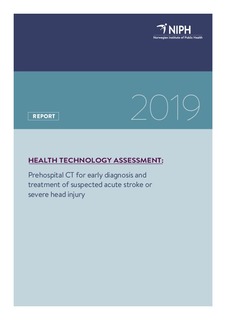| dc.contributor.author | Ormstad, Sari Susanna | |
| dc.contributor.author | Lund, Ulrikke Højslev | |
| dc.contributor.author | Chudasama, Kishan Kumar | |
| dc.contributor.author | Frønsdal, Katrine Bjørnebek | |
| dc.contributor.author | Hov, Maren Ranhoff | |
| dc.contributor.author | Ormberg, Ida | |
| dc.contributor.author | Hafstad, Elisabet Vivianne | |
| dc.contributor.author | Stoinska-Schneider, Anna | |
| dc.contributor.author | Robberstad, Bjarne | |
| dc.contributor.author | Lauvrak, Vigdis | |
| dc.contributor.author | Juvet, Lene Kristine | |
| dc.date.accessioned | 2019-11-22T11:52:29Z | |
| dc.date.available | 2019-11-22T11:52:29Z | |
| dc.date.created | 2019-06-28T12:51:18Z | |
| dc.date.issued | 2019 | |
| dc.identifier.isbn | 978-82-8406-005-7 | |
| dc.identifier.uri | http://hdl.handle.net/11250/2630060 | |
| dc.description.abstract | Key message
In Norway, approximately 12,000 persons experience acute stroke each year. Time is a crucial factor in the management of stroke, so rapid admission to a hospital for a computed tomography (CT) scan is recommended.
A mobile stroke unit (MSU), an ambulance equipped with a CT scanner, helps bring the hospital to the patient. Research evidence indicates that, compared with conventional care of acute stroke, MSU care probably leads to:
• reduced time from patient’s first contact with the emergency dispatch center to thrombolysis (treatment with a clot dissolving agent)
• increased number of patients who receive thrombolysis
MSU care may also lead to:
• reduced time from patient’s first contact with the emergency dispatch center to CT imaging
• better functionality at 3 months after stroke.
Our cost- and threshold analysis found that:
One MSU is estimated to cost approximately 6.4 million Norwegian kroner annually. The health gain measured in quality-adjusted life-years (QALYs) was 0.3 per patient receiving thrombolysis through MSU care compared with conventional care. We performed an analysis quantifying the severity criterion by calculating absolute shortfall for patients with acute ischemic stroke who receive conventional care. The results show an absolute shortfall of 5.5 QALYs. We found that the expected cost per QALY is approximately 385,000 Norwegian kroner or lower if one MSU successfully reaches at least 35-40% (145-171) of thrombolysis patients per year. | |
| dc.language.iso | eng | |
| dc.publisher | Norwegian Institute of Public Health, Division of Health Services | |
| dc.relation.uri | https://www.fhi.no/publ/2019/prehospital-ct-for-tidlig-diagnostikk-og-behandling-ved-mistanke-om-hjernes/ | |
| dc.subject.mesh | Stroke | |
| dc.subject.mesh | Craniocerebral Trauma | |
| dc.subject.mesh | Tomography Scanners, X-Ray Computed | |
| dc.subject.mesh | Tomography, X-Ray Computed | |
| dc.subject.mesh | Ambulances | |
| dc.subject.mesh | Mobile Health Units | |
| dc.subject.mesh | Time-to-Treatment | |
| dc.subject.mesh | Triage | |
| dc.subject.mesh | Technology Assessment, Biomedical | |
| dc.subject.mesh | Systematic Review as Topic | |
| dc.title | Prehospital CT for early diagnosis and treatment of suspected acute stroke or severe head injury. A health technology assessment | |
| dc.title.alternative | Prehospital CT for tidlig diagnostikk og behandling ved mistanke om hjerneslag eller alvorlige hodeskader. En metodevurdering | |
| dc.type | Research report | |
| dc.description.version | publishedVersion | |
| dc.source.pagenumber | 142 | |
| dc.identifier.cristin | 1708615 | |
| cristin.unitcode | 7502,9,1,0 | |
| cristin.unitcode | 7502,5,1,0 | |
| cristin.unitcode | 7502,9,4,0 | |
| cristin.unitname | Avdeling for vurdering av tiltak | |
| cristin.unitname | Avdeling for biobanker | |
| cristin.unitname | Avdeling for global helse | |
| cristin.ispublished | true | |
| cristin.fulltext | original | |
